Performance Management and Control: UWL Decision Making Report
VerifiedAdded on 2019/12/04
|11
|3182
|138
Report
AI Summary
This report analyzes performance management and control within the context of the University of West London (UWL), focusing on decision-making models and their impact on organizational effectiveness. The report contrasts centralised and decentralised models, examining their respective advantages and disadvantages, and argues in favour of a decentralised approach for UWL, particularly in light of the BREXIT issue. The analysis highlights the importance of involving various levels of management in decision-making, especially considering the diverse range of schools under UWL. The report also explores key performance measurement elements, such as rating scales, benchmarking, feedback mechanisms, and 360-degree feedback, and their application to the Claude Littner Business School. The report recommends that UWL adopt a decentralised model to enhance its decision-making processes, improve performance management, and ultimately inspire students to become innovative professionals. The report also suggests that the Claude Littner Business School should use various performance measurement elements for effective performance management and to achieve its goals.
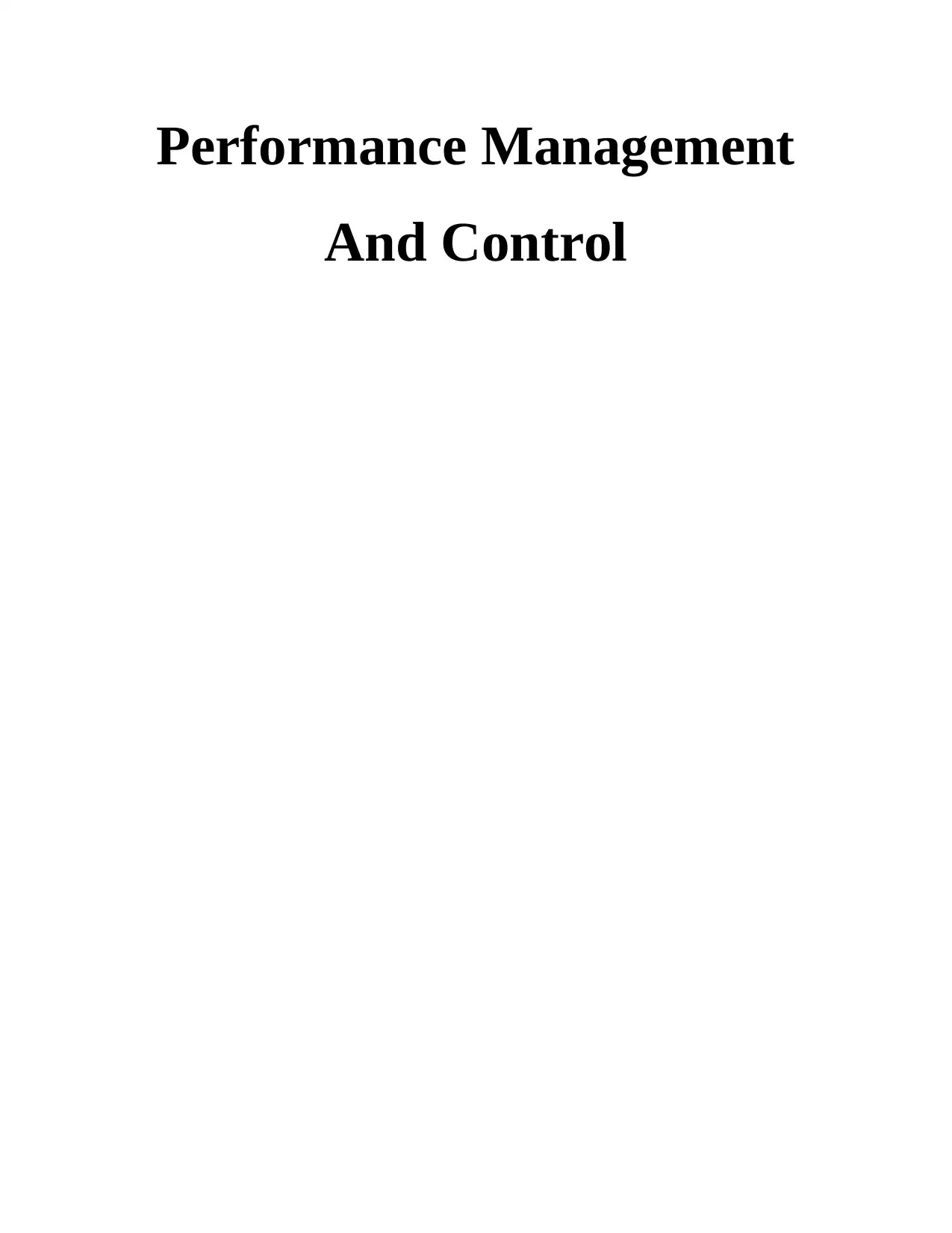
Performance Management
And Control
And Control
Paraphrase This Document
Need a fresh take? Get an instant paraphrase of this document with our AI Paraphraser
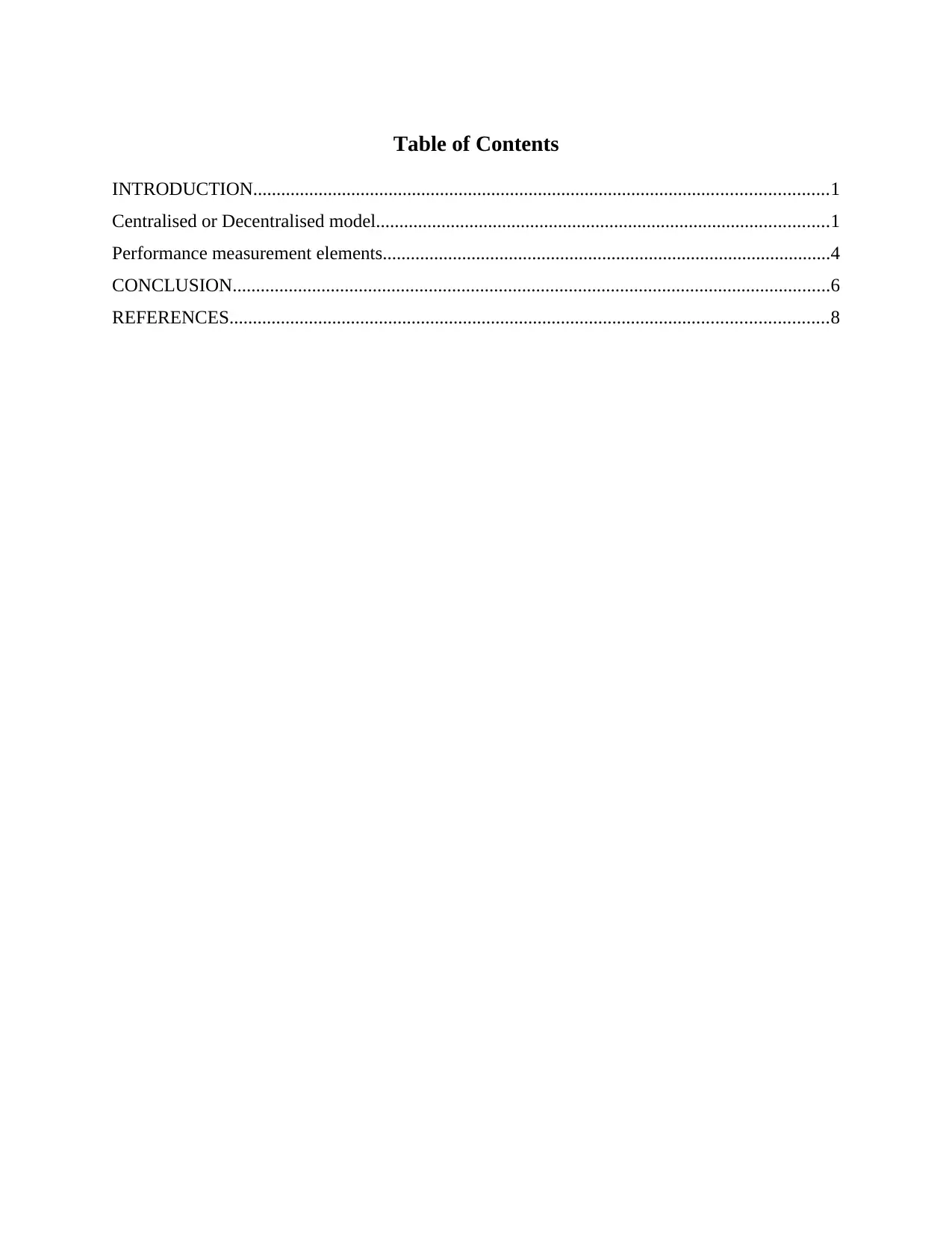
Table of Contents
INTRODUCTION...........................................................................................................................1
Centralised or Decentralised model.................................................................................................1
Performance measurement elements................................................................................................4
CONCLUSION................................................................................................................................6
REFERENCES................................................................................................................................8
INTRODUCTION...........................................................................................................................1
Centralised or Decentralised model.................................................................................................1
Performance measurement elements................................................................................................4
CONCLUSION................................................................................................................................6
REFERENCES................................................................................................................................8
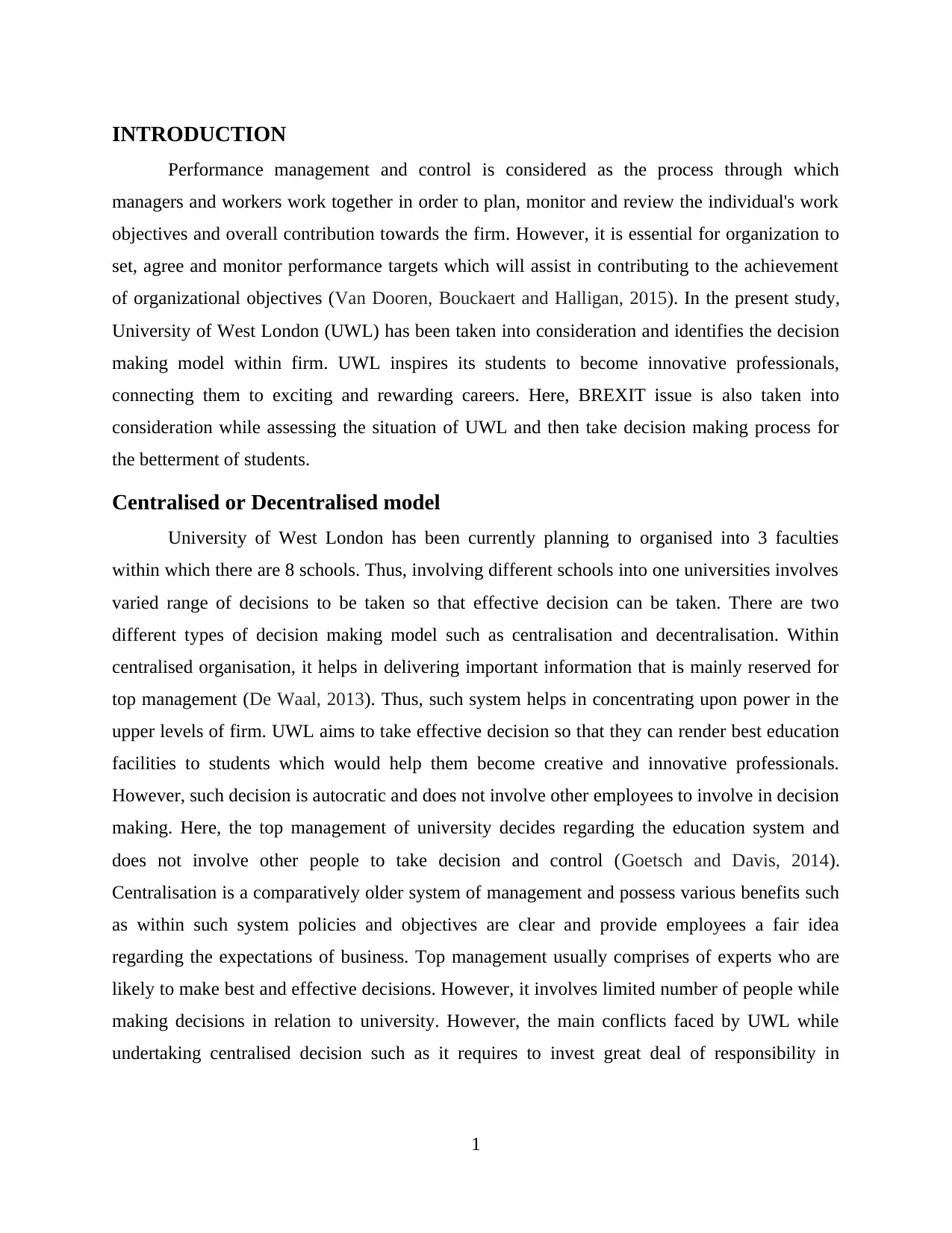
INTRODUCTION
Performance management and control is considered as the process through which
managers and workers work together in order to plan, monitor and review the individual's work
objectives and overall contribution towards the firm. However, it is essential for organization to
set, agree and monitor performance targets which will assist in contributing to the achievement
of organizational objectives (Van Dooren, Bouckaert and Halligan, 2015). In the present study,
University of West London (UWL) has been taken into consideration and identifies the decision
making model within firm. UWL inspires its students to become innovative professionals,
connecting them to exciting and rewarding careers. Here, BREXIT issue is also taken into
consideration while assessing the situation of UWL and then take decision making process for
the betterment of students.
Centralised or Decentralised model
University of West London has been currently planning to organised into 3 faculties
within which there are 8 schools. Thus, involving different schools into one universities involves
varied range of decisions to be taken so that effective decision can be taken. There are two
different types of decision making model such as centralisation and decentralisation. Within
centralised organisation, it helps in delivering important information that is mainly reserved for
top management (De Waal, 2013). Thus, such system helps in concentrating upon power in the
upper levels of firm. UWL aims to take effective decision so that they can render best education
facilities to students which would help them become creative and innovative professionals.
However, such decision is autocratic and does not involve other employees to involve in decision
making. Here, the top management of university decides regarding the education system and
does not involve other people to take decision and control (Goetsch and Davis, 2014).
Centralisation is a comparatively older system of management and possess various benefits such
as within such system policies and objectives are clear and provide employees a fair idea
regarding the expectations of business. Top management usually comprises of experts who are
likely to make best and effective decisions. However, it involves limited number of people while
making decisions in relation to university. However, the main conflicts faced by UWL while
undertaking centralised decision such as it requires to invest great deal of responsibility in
1
Performance management and control is considered as the process through which
managers and workers work together in order to plan, monitor and review the individual's work
objectives and overall contribution towards the firm. However, it is essential for organization to
set, agree and monitor performance targets which will assist in contributing to the achievement
of organizational objectives (Van Dooren, Bouckaert and Halligan, 2015). In the present study,
University of West London (UWL) has been taken into consideration and identifies the decision
making model within firm. UWL inspires its students to become innovative professionals,
connecting them to exciting and rewarding careers. Here, BREXIT issue is also taken into
consideration while assessing the situation of UWL and then take decision making process for
the betterment of students.
Centralised or Decentralised model
University of West London has been currently planning to organised into 3 faculties
within which there are 8 schools. Thus, involving different schools into one universities involves
varied range of decisions to be taken so that effective decision can be taken. There are two
different types of decision making model such as centralisation and decentralisation. Within
centralised organisation, it helps in delivering important information that is mainly reserved for
top management (De Waal, 2013). Thus, such system helps in concentrating upon power in the
upper levels of firm. UWL aims to take effective decision so that they can render best education
facilities to students which would help them become creative and innovative professionals.
However, such decision is autocratic and does not involve other employees to involve in decision
making. Here, the top management of university decides regarding the education system and
does not involve other people to take decision and control (Goetsch and Davis, 2014).
Centralisation is a comparatively older system of management and possess various benefits such
as within such system policies and objectives are clear and provide employees a fair idea
regarding the expectations of business. Top management usually comprises of experts who are
likely to make best and effective decisions. However, it involves limited number of people while
making decisions in relation to university. However, the main conflicts faced by UWL while
undertaking centralised decision such as it requires to invest great deal of responsibility in
1
⊘ This is a preview!⊘
Do you want full access?
Subscribe today to unlock all pages.

Trusted by 1+ million students worldwide
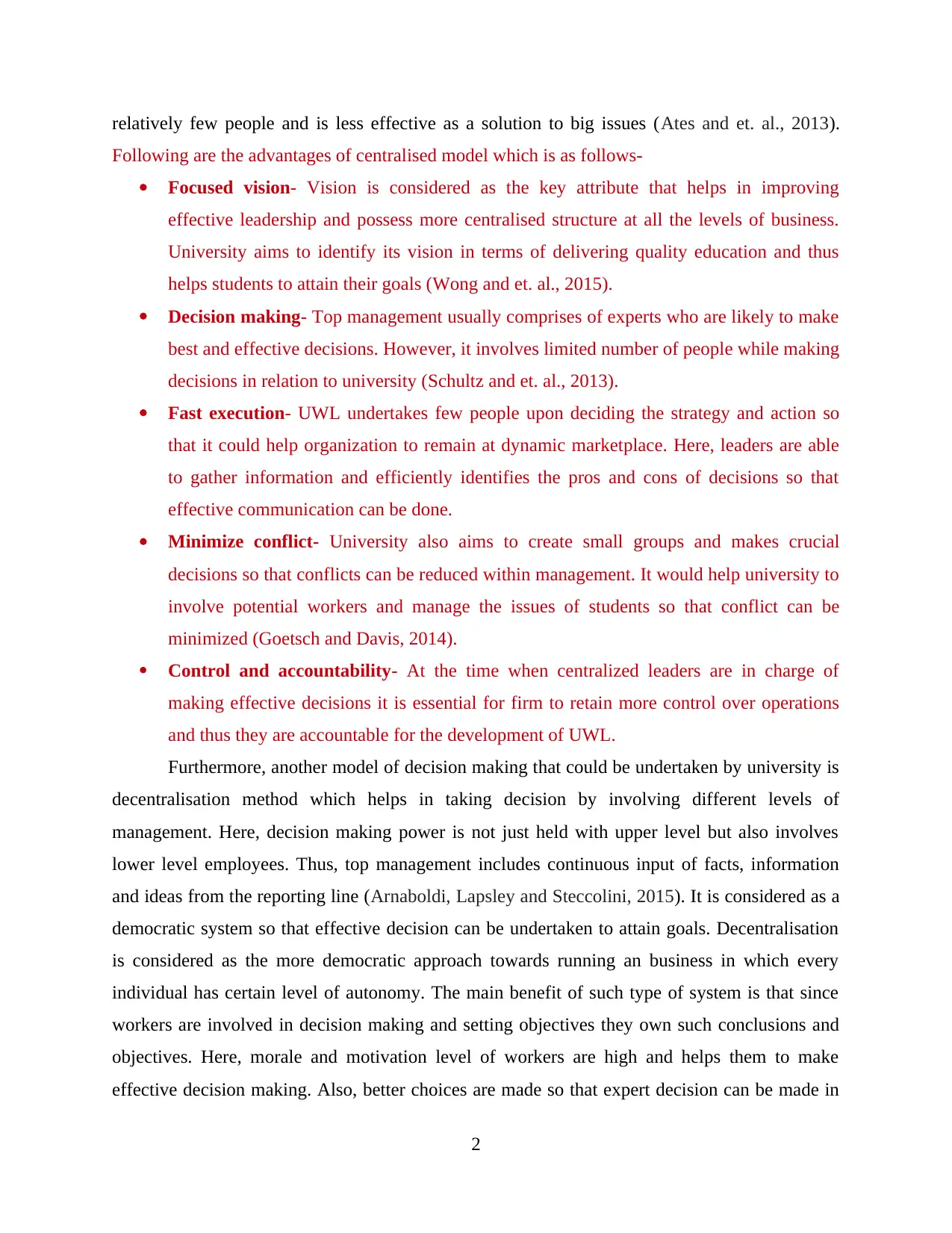
relatively few people and is less effective as a solution to big issues (Ates and et. al., 2013).
Following are the advantages of centralised model which is as follows-
Focused vision- Vision is considered as the key attribute that helps in improving
effective leadership and possess more centralised structure at all the levels of business.
University aims to identify its vision in terms of delivering quality education and thus
helps students to attain their goals (Wong and et. al., 2015).
Decision making- Top management usually comprises of experts who are likely to make
best and effective decisions. However, it involves limited number of people while making
decisions in relation to university (Schultz and et. al., 2013).
Fast execution- UWL undertakes few people upon deciding the strategy and action so
that it could help organization to remain at dynamic marketplace. Here, leaders are able
to gather information and efficiently identifies the pros and cons of decisions so that
effective communication can be done.
Minimize conflict- University also aims to create small groups and makes crucial
decisions so that conflicts can be reduced within management. It would help university to
involve potential workers and manage the issues of students so that conflict can be
minimized (Goetsch and Davis, 2014).
Control and accountability- At the time when centralized leaders are in charge of
making effective decisions it is essential for firm to retain more control over operations
and thus they are accountable for the development of UWL.
Furthermore, another model of decision making that could be undertaken by university is
decentralisation method which helps in taking decision by involving different levels of
management. Here, decision making power is not just held with upper level but also involves
lower level employees. Thus, top management includes continuous input of facts, information
and ideas from the reporting line (Arnaboldi, Lapsley and Steccolini, 2015). It is considered as a
democratic system so that effective decision can be undertaken to attain goals. Decentralisation
is considered as the more democratic approach towards running an business in which every
individual has certain level of autonomy. The main benefit of such type of system is that since
workers are involved in decision making and setting objectives they own such conclusions and
objectives. Here, morale and motivation level of workers are high and helps them to make
effective decision making. Also, better choices are made so that expert decision can be made in
2
Following are the advantages of centralised model which is as follows-
Focused vision- Vision is considered as the key attribute that helps in improving
effective leadership and possess more centralised structure at all the levels of business.
University aims to identify its vision in terms of delivering quality education and thus
helps students to attain their goals (Wong and et. al., 2015).
Decision making- Top management usually comprises of experts who are likely to make
best and effective decisions. However, it involves limited number of people while making
decisions in relation to university (Schultz and et. al., 2013).
Fast execution- UWL undertakes few people upon deciding the strategy and action so
that it could help organization to remain at dynamic marketplace. Here, leaders are able
to gather information and efficiently identifies the pros and cons of decisions so that
effective communication can be done.
Minimize conflict- University also aims to create small groups and makes crucial
decisions so that conflicts can be reduced within management. It would help university to
involve potential workers and manage the issues of students so that conflict can be
minimized (Goetsch and Davis, 2014).
Control and accountability- At the time when centralized leaders are in charge of
making effective decisions it is essential for firm to retain more control over operations
and thus they are accountable for the development of UWL.
Furthermore, another model of decision making that could be undertaken by university is
decentralisation method which helps in taking decision by involving different levels of
management. Here, decision making power is not just held with upper level but also involves
lower level employees. Thus, top management includes continuous input of facts, information
and ideas from the reporting line (Arnaboldi, Lapsley and Steccolini, 2015). It is considered as a
democratic system so that effective decision can be undertaken to attain goals. Decentralisation
is considered as the more democratic approach towards running an business in which every
individual has certain level of autonomy. The main benefit of such type of system is that since
workers are involved in decision making and setting objectives they own such conclusions and
objectives. Here, morale and motivation level of workers are high and helps them to make
effective decision making. Also, better choices are made so that expert decision can be made in
2
Paraphrase This Document
Need a fresh take? Get an instant paraphrase of this document with our AI Paraphraser
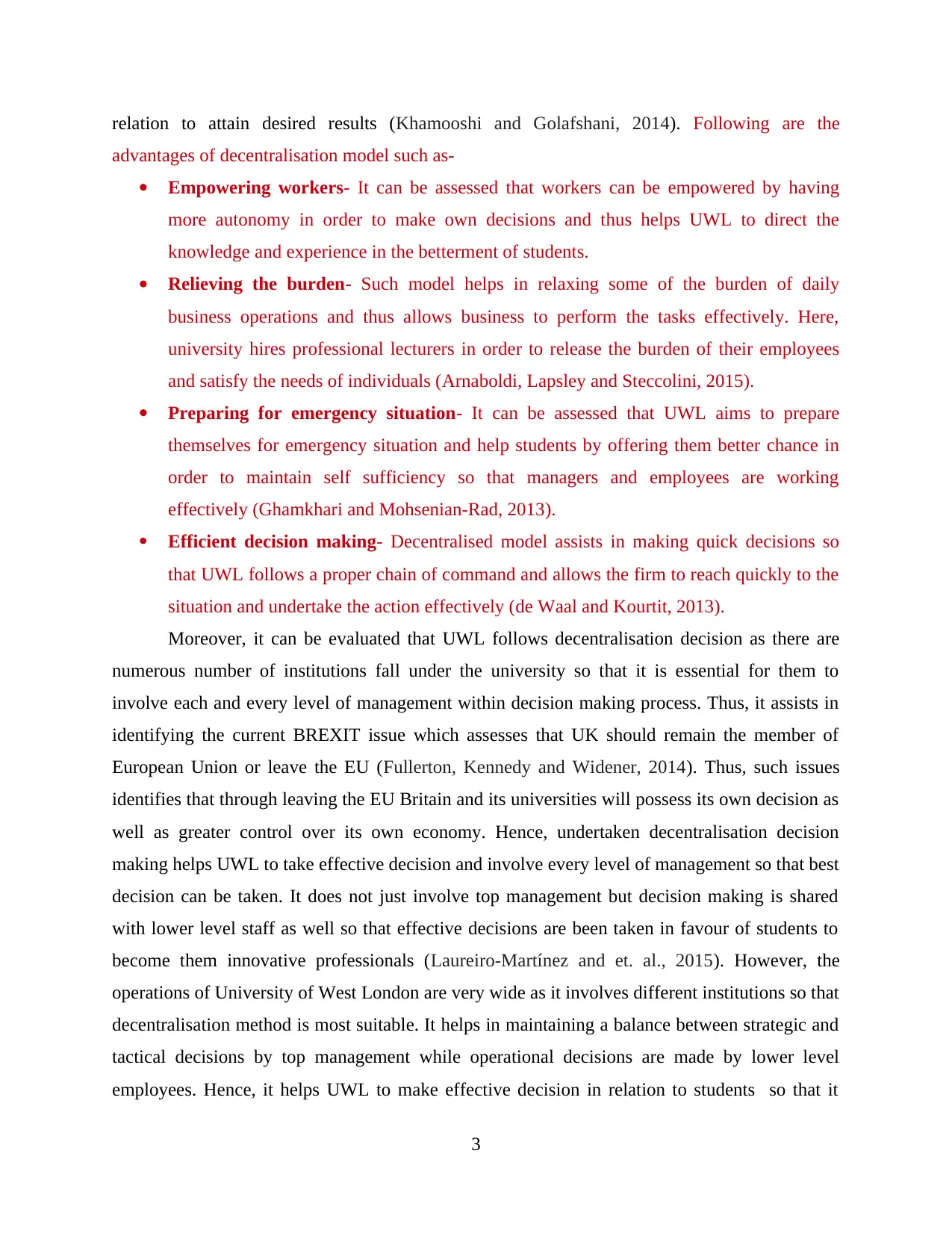
relation to attain desired results (Khamooshi and Golafshani, 2014). Following are the
advantages of decentralisation model such as-
Empowering workers- It can be assessed that workers can be empowered by having
more autonomy in order to make own decisions and thus helps UWL to direct the
knowledge and experience in the betterment of students.
Relieving the burden- Such model helps in relaxing some of the burden of daily
business operations and thus allows business to perform the tasks effectively. Here,
university hires professional lecturers in order to release the burden of their employees
and satisfy the needs of individuals (Arnaboldi, Lapsley and Steccolini, 2015).
Preparing for emergency situation- It can be assessed that UWL aims to prepare
themselves for emergency situation and help students by offering them better chance in
order to maintain self sufficiency so that managers and employees are working
effectively (Ghamkhari and Mohsenian-Rad, 2013).
Efficient decision making- Decentralised model assists in making quick decisions so
that UWL follows a proper chain of command and allows the firm to reach quickly to the
situation and undertake the action effectively (de Waal and Kourtit, 2013).
Moreover, it can be evaluated that UWL follows decentralisation decision as there are
numerous number of institutions fall under the university so that it is essential for them to
involve each and every level of management within decision making process. Thus, it assists in
identifying the current BREXIT issue which assesses that UK should remain the member of
European Union or leave the EU (Fullerton, Kennedy and Widener, 2014). Thus, such issues
identifies that through leaving the EU Britain and its universities will possess its own decision as
well as greater control over its own economy. Hence, undertaken decentralisation decision
making helps UWL to take effective decision and involve every level of management so that best
decision can be taken. It does not just involve top management but decision making is shared
with lower level staff as well so that effective decisions are been taken in favour of students to
become them innovative professionals (Laureiro‐Martínez and et. al., 2015). However, the
operations of University of West London are very wide as it involves different institutions so that
decentralisation method is most suitable. It helps in maintaining a balance between strategic and
tactical decisions by top management while operational decisions are made by lower level
employees. Hence, it helps UWL to make effective decision in relation to students so that it
3
advantages of decentralisation model such as-
Empowering workers- It can be assessed that workers can be empowered by having
more autonomy in order to make own decisions and thus helps UWL to direct the
knowledge and experience in the betterment of students.
Relieving the burden- Such model helps in relaxing some of the burden of daily
business operations and thus allows business to perform the tasks effectively. Here,
university hires professional lecturers in order to release the burden of their employees
and satisfy the needs of individuals (Arnaboldi, Lapsley and Steccolini, 2015).
Preparing for emergency situation- It can be assessed that UWL aims to prepare
themselves for emergency situation and help students by offering them better chance in
order to maintain self sufficiency so that managers and employees are working
effectively (Ghamkhari and Mohsenian-Rad, 2013).
Efficient decision making- Decentralised model assists in making quick decisions so
that UWL follows a proper chain of command and allows the firm to reach quickly to the
situation and undertake the action effectively (de Waal and Kourtit, 2013).
Moreover, it can be evaluated that UWL follows decentralisation decision as there are
numerous number of institutions fall under the university so that it is essential for them to
involve each and every level of management within decision making process. Thus, it assists in
identifying the current BREXIT issue which assesses that UK should remain the member of
European Union or leave the EU (Fullerton, Kennedy and Widener, 2014). Thus, such issues
identifies that through leaving the EU Britain and its universities will possess its own decision as
well as greater control over its own economy. Hence, undertaken decentralisation decision
making helps UWL to take effective decision and involve every level of management so that best
decision can be taken. It does not just involve top management but decision making is shared
with lower level staff as well so that effective decisions are been taken in favour of students to
become them innovative professionals (Laureiro‐Martínez and et. al., 2015). However, the
operations of University of West London are very wide as it involves different institutions so that
decentralisation method is most suitable. It helps in maintaining a balance between strategic and
tactical decisions by top management while operational decisions are made by lower level
employees. Hence, it helps UWL to make effective decision in relation to students so that it
3
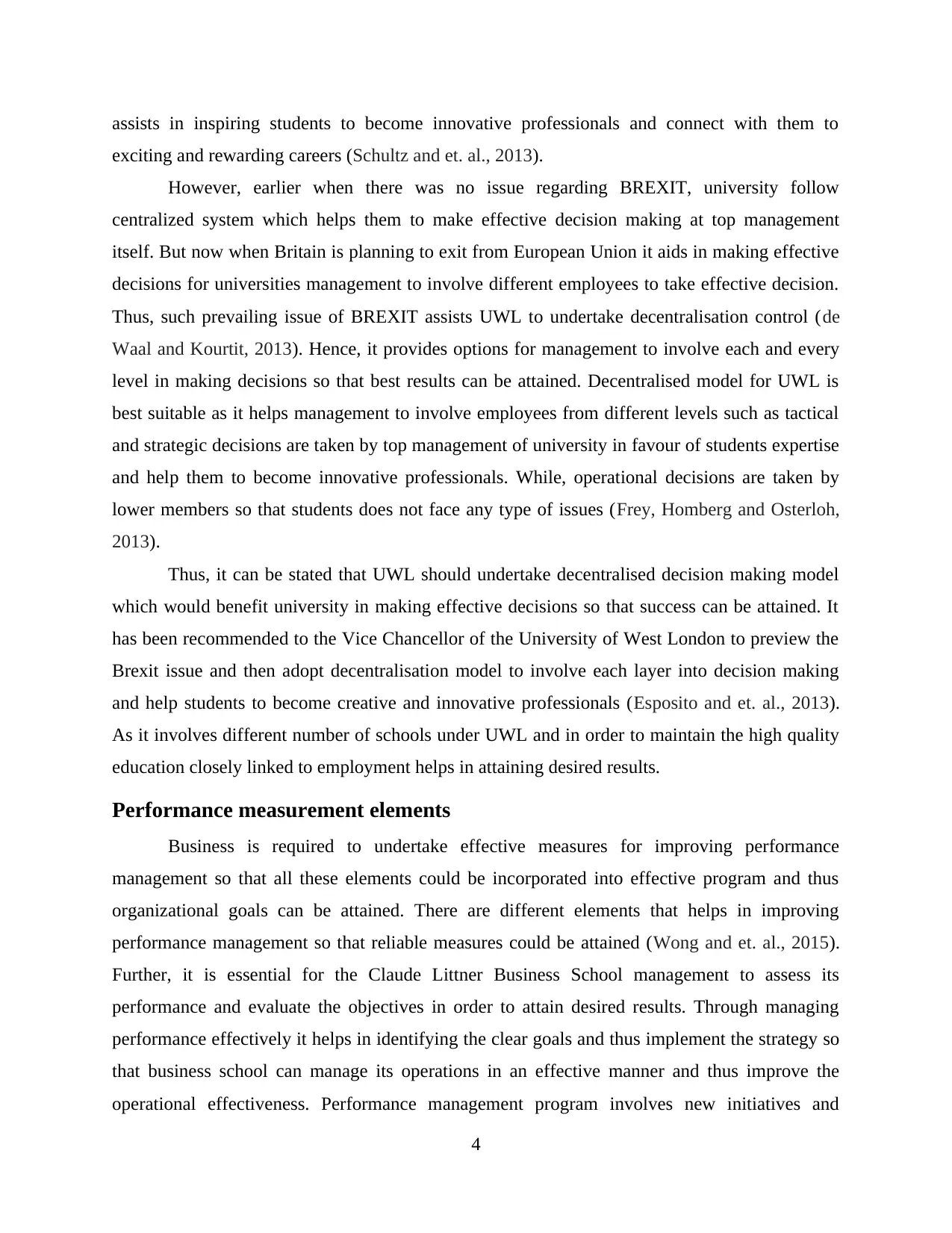
assists in inspiring students to become innovative professionals and connect with them to
exciting and rewarding careers (Schultz and et. al., 2013).
However, earlier when there was no issue regarding BREXIT, university follow
centralized system which helps them to make effective decision making at top management
itself. But now when Britain is planning to exit from European Union it aids in making effective
decisions for universities management to involve different employees to take effective decision.
Thus, such prevailing issue of BREXIT assists UWL to undertake decentralisation control (de
Waal and Kourtit, 2013). Hence, it provides options for management to involve each and every
level in making decisions so that best results can be attained. Decentralised model for UWL is
best suitable as it helps management to involve employees from different levels such as tactical
and strategic decisions are taken by top management of university in favour of students expertise
and help them to become innovative professionals. While, operational decisions are taken by
lower members so that students does not face any type of issues (Frey, Homberg and Osterloh,
2013).
Thus, it can be stated that UWL should undertake decentralised decision making model
which would benefit university in making effective decisions so that success can be attained. It
has been recommended to the Vice Chancellor of the University of West London to preview the
Brexit issue and then adopt decentralisation model to involve each layer into decision making
and help students to become creative and innovative professionals (Esposito and et. al., 2013).
As it involves different number of schools under UWL and in order to maintain the high quality
education closely linked to employment helps in attaining desired results.
Performance measurement elements
Business is required to undertake effective measures for improving performance
management so that all these elements could be incorporated into effective program and thus
organizational goals can be attained. There are different elements that helps in improving
performance management so that reliable measures could be attained (Wong and et. al., 2015).
Further, it is essential for the Claude Littner Business School management to assess its
performance and evaluate the objectives in order to attain desired results. Through managing
performance effectively it helps in identifying the clear goals and thus implement the strategy so
that business school can manage its operations in an effective manner and thus improve the
operational effectiveness. Performance management program involves new initiatives and
4
exciting and rewarding careers (Schultz and et. al., 2013).
However, earlier when there was no issue regarding BREXIT, university follow
centralized system which helps them to make effective decision making at top management
itself. But now when Britain is planning to exit from European Union it aids in making effective
decisions for universities management to involve different employees to take effective decision.
Thus, such prevailing issue of BREXIT assists UWL to undertake decentralisation control (de
Waal and Kourtit, 2013). Hence, it provides options for management to involve each and every
level in making decisions so that best results can be attained. Decentralised model for UWL is
best suitable as it helps management to involve employees from different levels such as tactical
and strategic decisions are taken by top management of university in favour of students expertise
and help them to become innovative professionals. While, operational decisions are taken by
lower members so that students does not face any type of issues (Frey, Homberg and Osterloh,
2013).
Thus, it can be stated that UWL should undertake decentralised decision making model
which would benefit university in making effective decisions so that success can be attained. It
has been recommended to the Vice Chancellor of the University of West London to preview the
Brexit issue and then adopt decentralisation model to involve each layer into decision making
and help students to become creative and innovative professionals (Esposito and et. al., 2013).
As it involves different number of schools under UWL and in order to maintain the high quality
education closely linked to employment helps in attaining desired results.
Performance measurement elements
Business is required to undertake effective measures for improving performance
management so that all these elements could be incorporated into effective program and thus
organizational goals can be attained. There are different elements that helps in improving
performance management so that reliable measures could be attained (Wong and et. al., 2015).
Further, it is essential for the Claude Littner Business School management to assess its
performance and evaluate the objectives in order to attain desired results. Through managing
performance effectively it helps in identifying the clear goals and thus implement the strategy so
that business school can manage its operations in an effective manner and thus improve the
operational effectiveness. Performance management program involves new initiatives and
4
⊘ This is a preview!⊘
Do you want full access?
Subscribe today to unlock all pages.

Trusted by 1+ million students worldwide
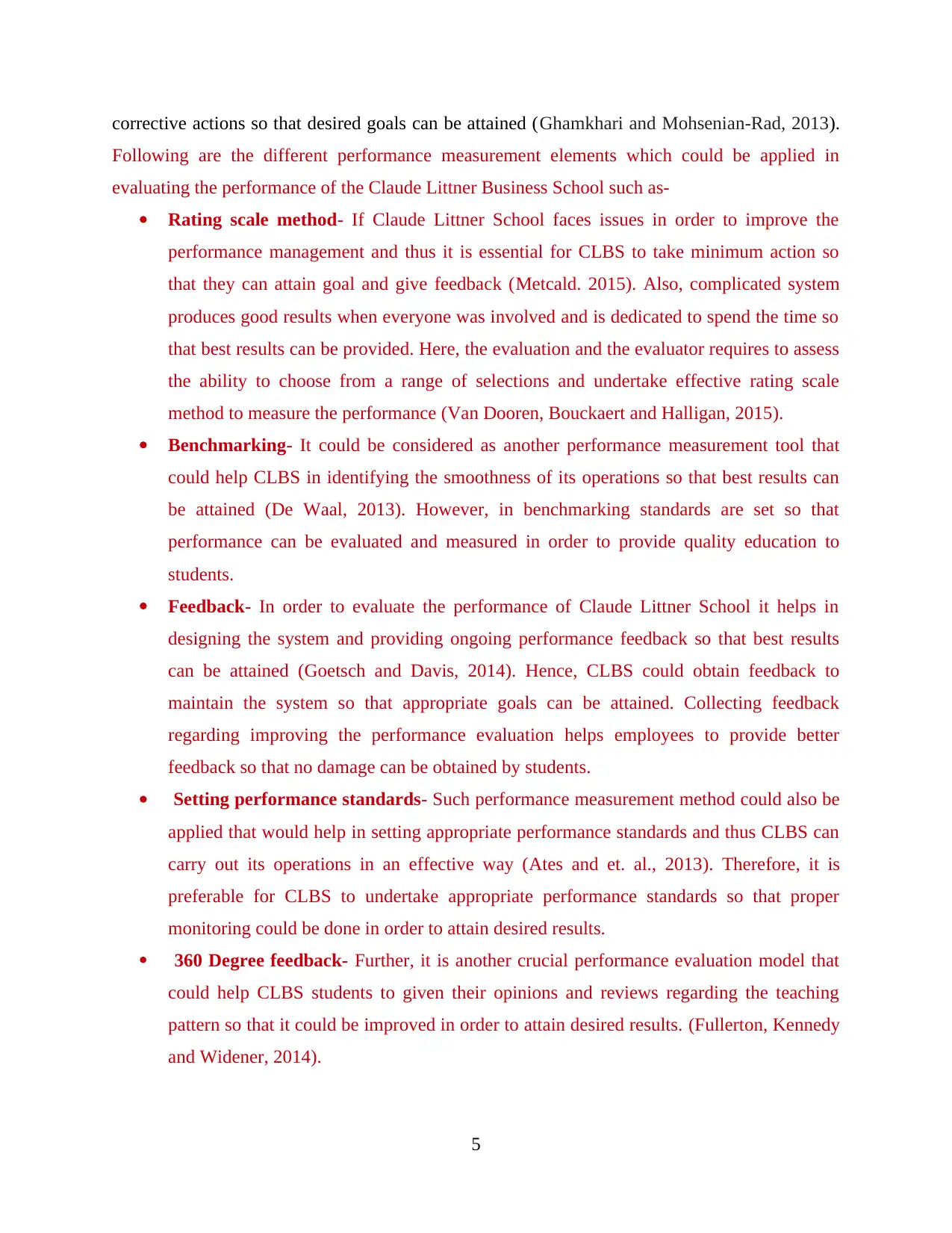
corrective actions so that desired goals can be attained (Ghamkhari and Mohsenian-Rad, 2013).
Following are the different performance measurement elements which could be applied in
evaluating the performance of the Claude Littner Business School such as-
Rating scale method- If Claude Littner School faces issues in order to improve the
performance management and thus it is essential for CLBS to take minimum action so
that they can attain goal and give feedback (Metcald. 2015). Also, complicated system
produces good results when everyone was involved and is dedicated to spend the time so
that best results can be provided. Here, the evaluation and the evaluator requires to assess
the ability to choose from a range of selections and undertake effective rating scale
method to measure the performance (Van Dooren, Bouckaert and Halligan, 2015).
Benchmarking- It could be considered as another performance measurement tool that
could help CLBS in identifying the smoothness of its operations so that best results can
be attained (De Waal, 2013). However, in benchmarking standards are set so that
performance can be evaluated and measured in order to provide quality education to
students.
Feedback- In order to evaluate the performance of Claude Littner School it helps in
designing the system and providing ongoing performance feedback so that best results
can be attained (Goetsch and Davis, 2014). Hence, CLBS could obtain feedback to
maintain the system so that appropriate goals can be attained. Collecting feedback
regarding improving the performance evaluation helps employees to provide better
feedback so that no damage can be obtained by students.
Setting performance standards- Such performance measurement method could also be
applied that would help in setting appropriate performance standards and thus CLBS can
carry out its operations in an effective way (Ates and et. al., 2013). Therefore, it is
preferable for CLBS to undertake appropriate performance standards so that proper
monitoring could be done in order to attain desired results.
360 Degree feedback- Further, it is another crucial performance evaluation model that
could help CLBS students to given their opinions and reviews regarding the teaching
pattern so that it could be improved in order to attain desired results. (Fullerton, Kennedy
and Widener, 2014).
5
Following are the different performance measurement elements which could be applied in
evaluating the performance of the Claude Littner Business School such as-
Rating scale method- If Claude Littner School faces issues in order to improve the
performance management and thus it is essential for CLBS to take minimum action so
that they can attain goal and give feedback (Metcald. 2015). Also, complicated system
produces good results when everyone was involved and is dedicated to spend the time so
that best results can be provided. Here, the evaluation and the evaluator requires to assess
the ability to choose from a range of selections and undertake effective rating scale
method to measure the performance (Van Dooren, Bouckaert and Halligan, 2015).
Benchmarking- It could be considered as another performance measurement tool that
could help CLBS in identifying the smoothness of its operations so that best results can
be attained (De Waal, 2013). However, in benchmarking standards are set so that
performance can be evaluated and measured in order to provide quality education to
students.
Feedback- In order to evaluate the performance of Claude Littner School it helps in
designing the system and providing ongoing performance feedback so that best results
can be attained (Goetsch and Davis, 2014). Hence, CLBS could obtain feedback to
maintain the system so that appropriate goals can be attained. Collecting feedback
regarding improving the performance evaluation helps employees to provide better
feedback so that no damage can be obtained by students.
Setting performance standards- Such performance measurement method could also be
applied that would help in setting appropriate performance standards and thus CLBS can
carry out its operations in an effective way (Ates and et. al., 2013). Therefore, it is
preferable for CLBS to undertake appropriate performance standards so that proper
monitoring could be done in order to attain desired results.
360 Degree feedback- Further, it is another crucial performance evaluation model that
could help CLBS students to given their opinions and reviews regarding the teaching
pattern so that it could be improved in order to attain desired results. (Fullerton, Kennedy
and Widener, 2014).
5
Paraphrase This Document
Need a fresh take? Get an instant paraphrase of this document with our AI Paraphraser
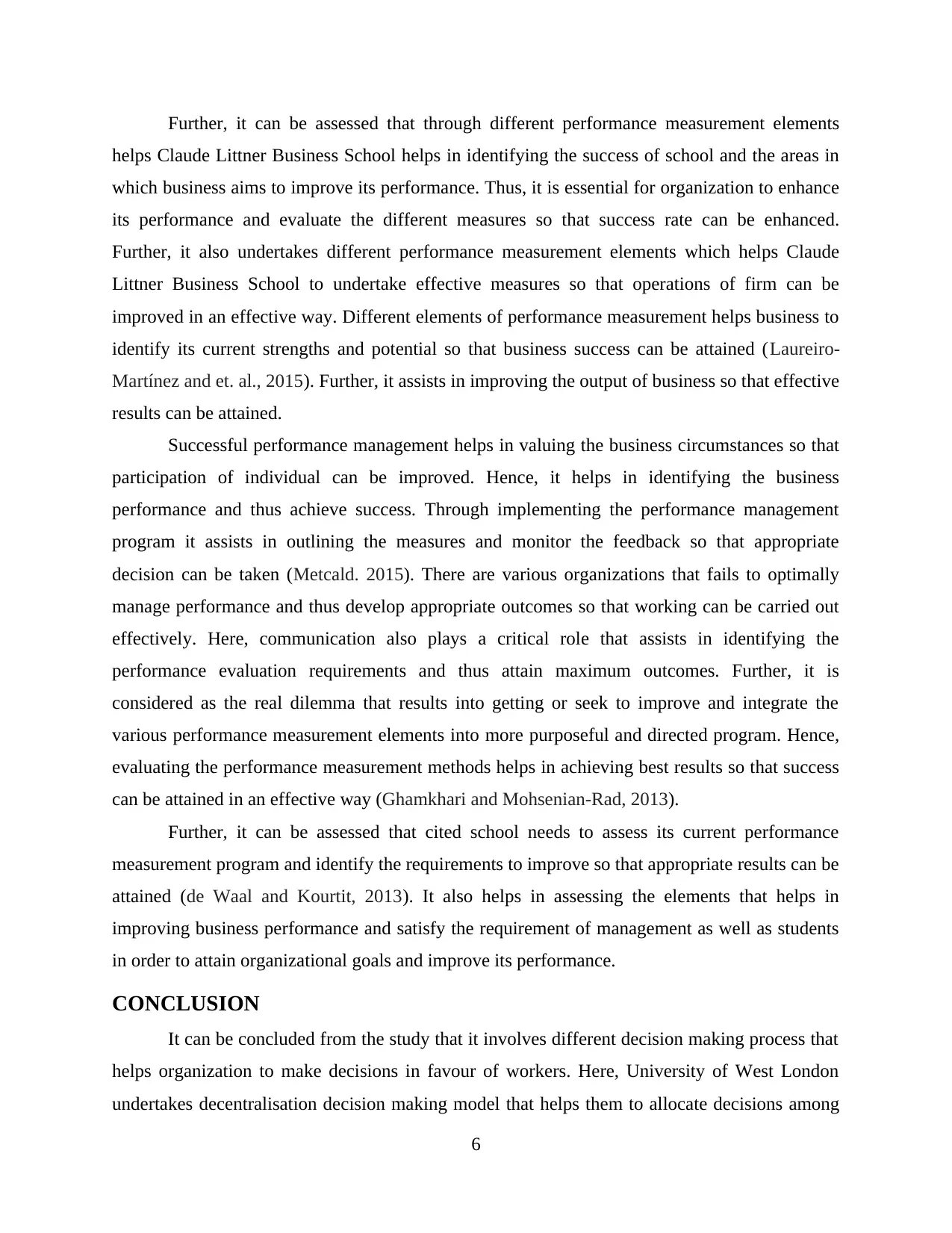
Further, it can be assessed that through different performance measurement elements
helps Claude Littner Business School helps in identifying the success of school and the areas in
which business aims to improve its performance. Thus, it is essential for organization to enhance
its performance and evaluate the different measures so that success rate can be enhanced.
Further, it also undertakes different performance measurement elements which helps Claude
Littner Business School to undertake effective measures so that operations of firm can be
improved in an effective way. Different elements of performance measurement helps business to
identify its current strengths and potential so that business success can be attained (Laureiro‐
Martínez and et. al., 2015). Further, it assists in improving the output of business so that effective
results can be attained.
Successful performance management helps in valuing the business circumstances so that
participation of individual can be improved. Hence, it helps in identifying the business
performance and thus achieve success. Through implementing the performance management
program it assists in outlining the measures and monitor the feedback so that appropriate
decision can be taken (Metcald. 2015). There are various organizations that fails to optimally
manage performance and thus develop appropriate outcomes so that working can be carried out
effectively. Here, communication also plays a critical role that assists in identifying the
performance evaluation requirements and thus attain maximum outcomes. Further, it is
considered as the real dilemma that results into getting or seek to improve and integrate the
various performance measurement elements into more purposeful and directed program. Hence,
evaluating the performance measurement methods helps in achieving best results so that success
can be attained in an effective way (Ghamkhari and Mohsenian-Rad, 2013).
Further, it can be assessed that cited school needs to assess its current performance
measurement program and identify the requirements to improve so that appropriate results can be
attained (de Waal and Kourtit, 2013). It also helps in assessing the elements that helps in
improving business performance and satisfy the requirement of management as well as students
in order to attain organizational goals and improve its performance.
CONCLUSION
It can be concluded from the study that it involves different decision making process that
helps organization to make decisions in favour of workers. Here, University of West London
undertakes decentralisation decision making model that helps them to allocate decisions among
6
helps Claude Littner Business School helps in identifying the success of school and the areas in
which business aims to improve its performance. Thus, it is essential for organization to enhance
its performance and evaluate the different measures so that success rate can be enhanced.
Further, it also undertakes different performance measurement elements which helps Claude
Littner Business School to undertake effective measures so that operations of firm can be
improved in an effective way. Different elements of performance measurement helps business to
identify its current strengths and potential so that business success can be attained (Laureiro‐
Martínez and et. al., 2015). Further, it assists in improving the output of business so that effective
results can be attained.
Successful performance management helps in valuing the business circumstances so that
participation of individual can be improved. Hence, it helps in identifying the business
performance and thus achieve success. Through implementing the performance management
program it assists in outlining the measures and monitor the feedback so that appropriate
decision can be taken (Metcald. 2015). There are various organizations that fails to optimally
manage performance and thus develop appropriate outcomes so that working can be carried out
effectively. Here, communication also plays a critical role that assists in identifying the
performance evaluation requirements and thus attain maximum outcomes. Further, it is
considered as the real dilemma that results into getting or seek to improve and integrate the
various performance measurement elements into more purposeful and directed program. Hence,
evaluating the performance measurement methods helps in achieving best results so that success
can be attained in an effective way (Ghamkhari and Mohsenian-Rad, 2013).
Further, it can be assessed that cited school needs to assess its current performance
measurement program and identify the requirements to improve so that appropriate results can be
attained (de Waal and Kourtit, 2013). It also helps in assessing the elements that helps in
improving business performance and satisfy the requirement of management as well as students
in order to attain organizational goals and improve its performance.
CONCLUSION
It can be concluded from the study that it involves different decision making process that
helps organization to make decisions in favour of workers. Here, University of West London
undertakes decentralisation decision making model that helps them to allocate decisions among
6
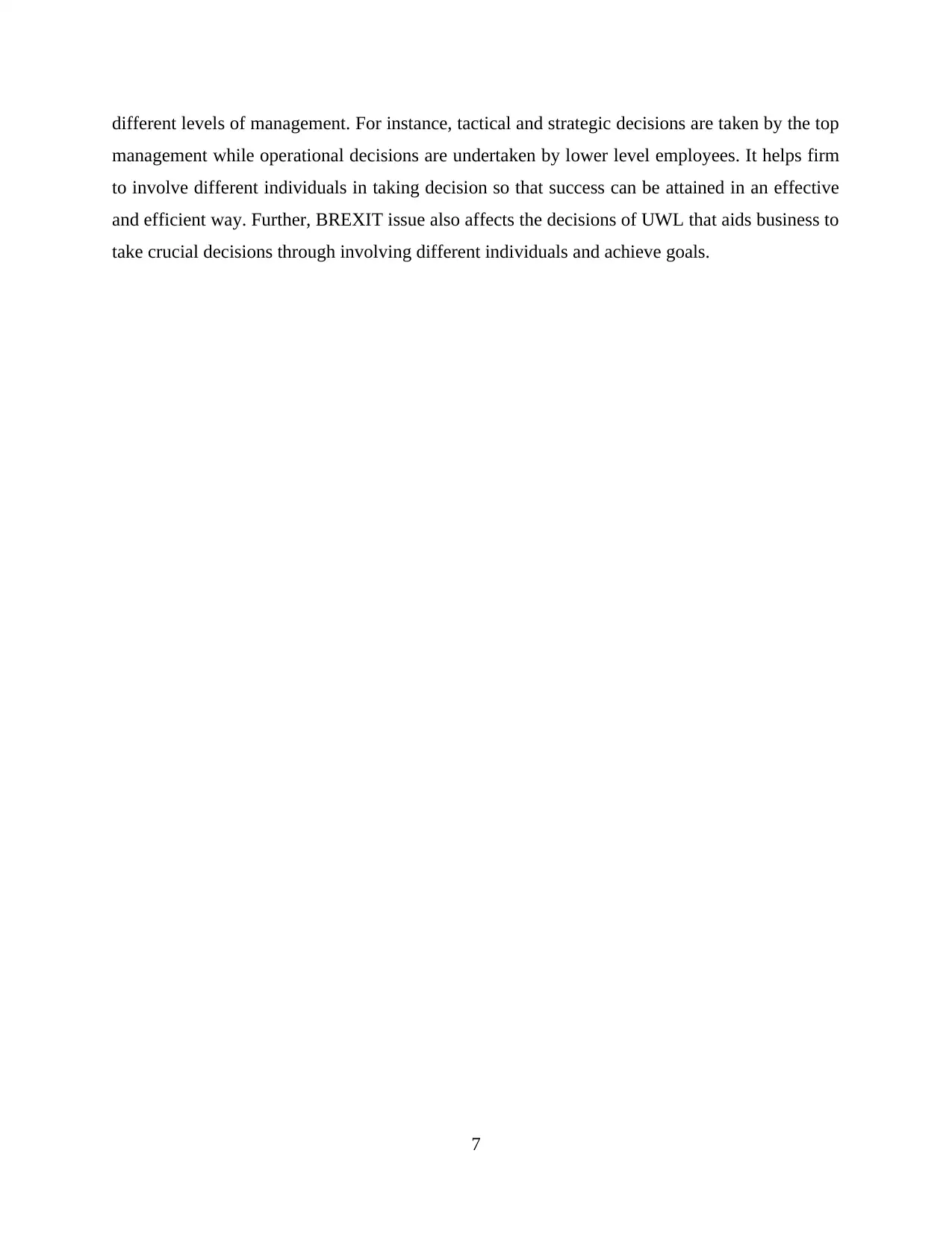
different levels of management. For instance, tactical and strategic decisions are taken by the top
management while operational decisions are undertaken by lower level employees. It helps firm
to involve different individuals in taking decision so that success can be attained in an effective
and efficient way. Further, BREXIT issue also affects the decisions of UWL that aids business to
take crucial decisions through involving different individuals and achieve goals.
7
management while operational decisions are undertaken by lower level employees. It helps firm
to involve different individuals in taking decision so that success can be attained in an effective
and efficient way. Further, BREXIT issue also affects the decisions of UWL that aids business to
take crucial decisions through involving different individuals and achieve goals.
7
⊘ This is a preview!⊘
Do you want full access?
Subscribe today to unlock all pages.

Trusted by 1+ million students worldwide
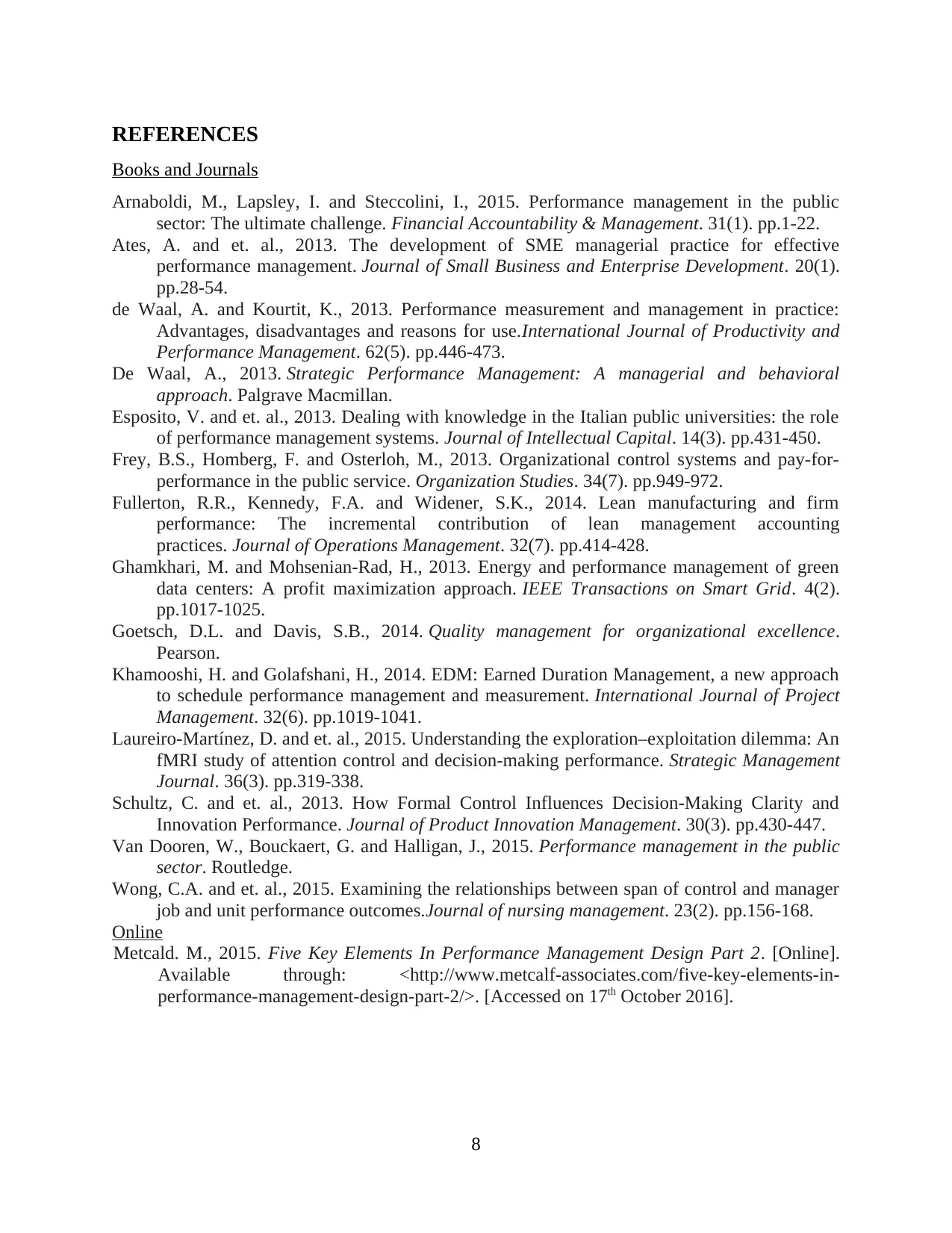
REFERENCES
Books and Journals
Arnaboldi, M., Lapsley, I. and Steccolini, I., 2015. Performance management in the public
sector: The ultimate challenge. Financial Accountability & Management. 31(1). pp.1-22.
Ates, A. and et. al., 2013. The development of SME managerial practice for effective
performance management. Journal of Small Business and Enterprise Development. 20(1).
pp.28-54.
de Waal, A. and Kourtit, K., 2013. Performance measurement and management in practice:
Advantages, disadvantages and reasons for use.International Journal of Productivity and
Performance Management. 62(5). pp.446-473.
De Waal, A., 2013. Strategic Performance Management: A managerial and behavioral
approach. Palgrave Macmillan.
Esposito, V. and et. al., 2013. Dealing with knowledge in the Italian public universities: the role
of performance management systems. Journal of Intellectual Capital. 14(3). pp.431-450.
Frey, B.S., Homberg, F. and Osterloh, M., 2013. Organizational control systems and pay-for-
performance in the public service. Organization Studies. 34(7). pp.949-972.
Fullerton, R.R., Kennedy, F.A. and Widener, S.K., 2014. Lean manufacturing and firm
performance: The incremental contribution of lean management accounting
practices. Journal of Operations Management. 32(7). pp.414-428.
Ghamkhari, M. and Mohsenian-Rad, H., 2013. Energy and performance management of green
data centers: A profit maximization approach. IEEE Transactions on Smart Grid. 4(2).
pp.1017-1025.
Goetsch, D.L. and Davis, S.B., 2014. Quality management for organizational excellence.
Pearson.
Khamooshi, H. and Golafshani, H., 2014. EDM: Earned Duration Management, a new approach
to schedule performance management and measurement. International Journal of Project
Management. 32(6). pp.1019-1041.
Laureiro‐Martínez, D. and et. al., 2015. Understanding the exploration–exploitation dilemma: An
fMRI study of attention control and decision‐making performance. Strategic Management
Journal. 36(3). pp.319-338.
Schultz, C. and et. al., 2013. How Formal Control Influences Decision‐Making Clarity and
Innovation Performance. Journal of Product Innovation Management. 30(3). pp.430-447.
Van Dooren, W., Bouckaert, G. and Halligan, J., 2015. Performance management in the public
sector. Routledge.
Wong, C.A. and et. al., 2015. Examining the relationships between span of control and manager
job and unit performance outcomes.Journal of nursing management. 23(2). pp.156-168.
Online
Metcald. M., 2015. Five Key Elements In Performance Management Design Part 2. [Online].
Available through: <http://www.metcalf-associates.com/five-key-elements-in-
performance-management-design-part-2/>. [Accessed on 17th October 2016].
8
Books and Journals
Arnaboldi, M., Lapsley, I. and Steccolini, I., 2015. Performance management in the public
sector: The ultimate challenge. Financial Accountability & Management. 31(1). pp.1-22.
Ates, A. and et. al., 2013. The development of SME managerial practice for effective
performance management. Journal of Small Business and Enterprise Development. 20(1).
pp.28-54.
de Waal, A. and Kourtit, K., 2013. Performance measurement and management in practice:
Advantages, disadvantages and reasons for use.International Journal of Productivity and
Performance Management. 62(5). pp.446-473.
De Waal, A., 2013. Strategic Performance Management: A managerial and behavioral
approach. Palgrave Macmillan.
Esposito, V. and et. al., 2013. Dealing with knowledge in the Italian public universities: the role
of performance management systems. Journal of Intellectual Capital. 14(3). pp.431-450.
Frey, B.S., Homberg, F. and Osterloh, M., 2013. Organizational control systems and pay-for-
performance in the public service. Organization Studies. 34(7). pp.949-972.
Fullerton, R.R., Kennedy, F.A. and Widener, S.K., 2014. Lean manufacturing and firm
performance: The incremental contribution of lean management accounting
practices. Journal of Operations Management. 32(7). pp.414-428.
Ghamkhari, M. and Mohsenian-Rad, H., 2013. Energy and performance management of green
data centers: A profit maximization approach. IEEE Transactions on Smart Grid. 4(2).
pp.1017-1025.
Goetsch, D.L. and Davis, S.B., 2014. Quality management for organizational excellence.
Pearson.
Khamooshi, H. and Golafshani, H., 2014. EDM: Earned Duration Management, a new approach
to schedule performance management and measurement. International Journal of Project
Management. 32(6). pp.1019-1041.
Laureiro‐Martínez, D. and et. al., 2015. Understanding the exploration–exploitation dilemma: An
fMRI study of attention control and decision‐making performance. Strategic Management
Journal. 36(3). pp.319-338.
Schultz, C. and et. al., 2013. How Formal Control Influences Decision‐Making Clarity and
Innovation Performance. Journal of Product Innovation Management. 30(3). pp.430-447.
Van Dooren, W., Bouckaert, G. and Halligan, J., 2015. Performance management in the public
sector. Routledge.
Wong, C.A. and et. al., 2015. Examining the relationships between span of control and manager
job and unit performance outcomes.Journal of nursing management. 23(2). pp.156-168.
Online
Metcald. M., 2015. Five Key Elements In Performance Management Design Part 2. [Online].
Available through: <http://www.metcalf-associates.com/five-key-elements-in-
performance-management-design-part-2/>. [Accessed on 17th October 2016].
8
Paraphrase This Document
Need a fresh take? Get an instant paraphrase of this document with our AI Paraphraser

9
1 out of 11
Related Documents
Your All-in-One AI-Powered Toolkit for Academic Success.
+13062052269
info@desklib.com
Available 24*7 on WhatsApp / Email
![[object Object]](/_next/static/media/star-bottom.7253800d.svg)
Unlock your academic potential
Copyright © 2020–2025 A2Z Services. All Rights Reserved. Developed and managed by ZUCOL.





